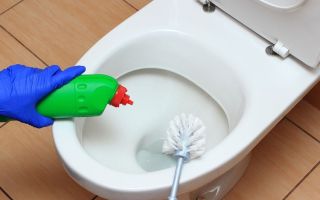Content
- 1 Features of removing rust from the toilet at home
- 2 How to clean rust from the toilet using folk methods
- 2.1 How to clean rust in a toilet with vinegar
- 2.2 How to clean a toilet bowl from rust with ammonia and peroxide
- 2.3 How to clean rust in a toilet with oxalic acid
- 2.4 How to get rid of rust in the toilet with baking soda
- 2.5 How to remove rust from a toilet bowl with whiteness
- 2.6 How to clean a rusty toilet with toothpaste
- 2.7 How to clean a toilet bowl from rust with electrolyte
- 3 How to remove rusty deposits in the toilet with specialized products
- 4 Preventing rust in the toilet
- 5 Conclusion
- 6 Reviews on how to remove rust on the toilet
It is quite possible to clean the toilet bowl from rust at home, even if the rust has accumulated on the walls of the bowl for a very long time. You can use chemical and household products; if used correctly, they bring the same benefits.
Features of removing rust from the toilet at home
In the absence of regular prophylaxis, rusty deposits sooner or later appear on the walls of any toilet bowl. The reason is that the inside of the plumbing bowl is constantly moistened, and the mineral salts in the water form a hard coating over time. At the same time, rust forms faster in the toilet bowl, the water in which is drained less often, deposits are not washed off the walls of the bowl during the drain process.
Several factors accelerate the appearance of rust, namely:
- poor quality tap water with a high content of metallic impurities;
- faulty tank from which water constantly leaks;
- rough inner surface of the toilet bowl - mineral salts are retained in microscopic pores of faience.
Rust not only spoils the appearance of plumbing, but also contributes to the spread of germs and unpleasant odors. There are a few things to consider when cleaning:
- If you need to clean the plumbing from rust, it is better to use soft brushes and sponges that do not scratch the surface of the bowl. The use of hard scrapers will lead to the fact that in the future, plaque will only form faster.
- To clean the plumbing faster, you need to do this at the first sign of yellow plaque. The more visible the rusty strip in the toilet, the more difficult it will be to remove.
- Before cleaning, excess water from the toilet bowl should be removed with a ladle, you can also wipe the walls with paper towels or a dry rag. Cleaning agents will be more effective if used on dry earthenware surfaces.
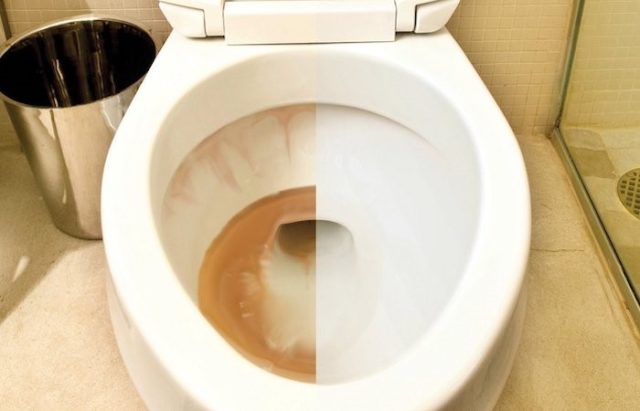
How to clean rust from the toilet using folk methods
It is possible to remove rust from the toilet from the water and return the whiteness to the plumbing even without the use of special chemicals. Some household substances contain acids and alkalis in their composition, therefore they are good solvents.
How to clean rust in a toilet with vinegar
One of the most popular home remedies for toilet rust removal is table vinegar.It dissolves even difficult dirt well and helps to clean the toilet bowl from rusty marks. They use it like this:
- the walls of the toilet bowl and all contaminated places are watered with vinegar or thoroughly wiped with a sponge, abundantly moistened with a solution;
- leave the agent for half an hour so that it works properly;
- are passed over the toilet bowl with a brush or a thick sponge, after which the water is flushed several times.
Another way is to use vinegar in combination with citric acid. 2 bags of acid are poured inside the plumbing fixture, trying to make sure that the fine powder properly covers all problem areas.
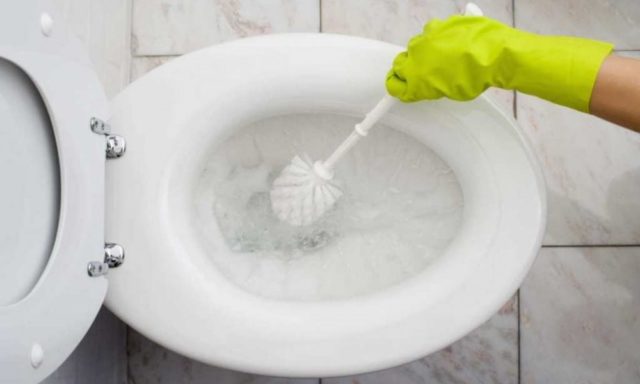
After that, vinegar is sprayed from a spray bottle over citric acid and the foaming agent is left for 30 minutes. In half an hour, both components will soften the rust and can be easily cleaned with a brush or sponge.
How to clean a toilet bowl from rust with ammonia and peroxide
Another proven method is to clean rust with ammonia and hydrogen peroxide - both are usually found in any medicine cabinet. The cleaning mixture is prepared simply - ammonia and peroxide are mixed in a ratio of 1 to 20, and then a soft sponge is moistened in the solution and treated with rust.
You need to leave the product in the toilet for several hours, so it is most convenient to handle the plumbing in the evening. In the morning, you will need to walk along the walls of the bowl with a brush and rinse the water 2-3 times to clean the rust in the toilet on the drain and remove the remaining cleaning mixture.
How to clean rust in a toilet with oxalic acid
Oxalic acid has good corrosive properties. It should be used carefully, without inhaling vapors and without touching the powder with bare hands, but if safety precautions are followed, the acid will give a very good effect.
It is used this way - with a sponge, spread the powder in a dense layer over rusty streaks, if necessary, the acid can be slightly diluted with water. Then the product is left inside the toilet for an hour, and then the walls are treated with a toilet brush or the hard side of a sponge and the plumbing is thoroughly washed.
How to get rid of rust in the toilet with baking soda
Baking soda works well for removing stubborn dirt, including rust. To clean yellow spots on faience, you need to dilute a small amount of soda with water to a gruel state and distribute over the contaminated areas. It takes about 1.5 hours to keep the soda on the walls of the plumbing, after which the toilet is cleaned in a standard way and the water is drained several times in a row.
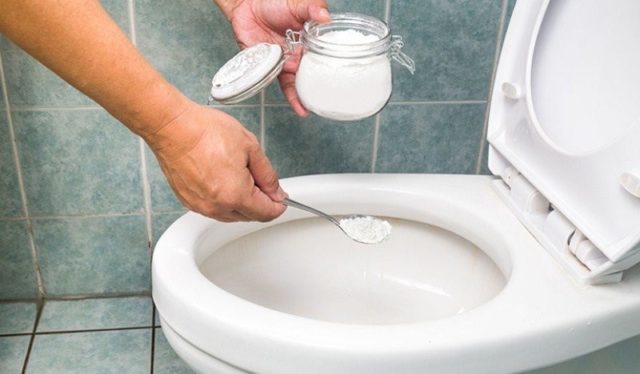
Soda makes it even more effective to flush rust from the toilet in combination with vinegar. First, you need to boil 250 ml of vinegar on the stove, and then dilute 2 large tablespoons of soda powder in a hot liquid. A warm agent is applied to the faience walls of the plumbing fixtures and left for a couple of hours, after which the toilet bowl is properly cleaned with a sponge or brush.
How to remove rust from a toilet bowl with whiteness
The famous chlorine bleach helps to deal with more than just dirt on clothes. Whiteness is an excellent solvent and copes with limescale, urinary calculus and rust.
In order to remove rust from the toilet as effectively as possible, it is necessary to pour the toilet abundantly from the inside with Whiteness in the evening, lower the lid and leave the product for 10 hours. In the morning, you will need to clean the rusty coating with a sponge or brush, and then drain the water twice or three times to remove the remaining Whiteness.
Chlorine-based bleach effectively copes with solid deposits, but if desired, whiteness can be used in combination with other substances.For example, you can first clean the toilet with baking soda and then use bleach.
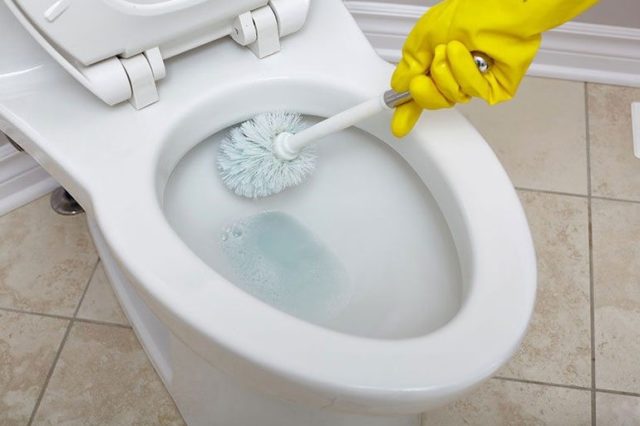
How to clean a rusty toilet with toothpaste
Ordinary toothpaste helps to clean rusty marks on the toilet, it contains substances that remove solid deposits. It is very simple to use the paste - it must be evenly distributed over the contaminated surface and left for half an hour. Then the traces of rust must be thoroughly cleaned with a brush or brush, and then the water must be drained.
Additional advantages of toothpaste include the fact that after its use in the toilet, a pleasant smell of freshness remains. However, it must be borne in mind that the paste will not cope with serious traces of rust, it will help to clean only weak deposits.
How to clean a toilet bowl from rust with electrolyte
One of the strongest anti-rust agents is automotive electrolyte. It contains sulfuric acid, which is guaranteed to help wash out old rust in the toilet, even if the dirt is very dense. The electrolyte is used as follows - with very great care, about 150 ml of liquid is poured into the toilet, making sure that the electrolyte gets to the places of contamination. After just 15 minutes, the water is drained several times to completely wash off the remaining electrolyte.
When working with a hazardous caustic substance, special safety rules must be observed. You can use the most effective rust remover in the toilet only with a respirator and protective gloves, you must not allow the agent to get on the plastic elements of the plumbing.
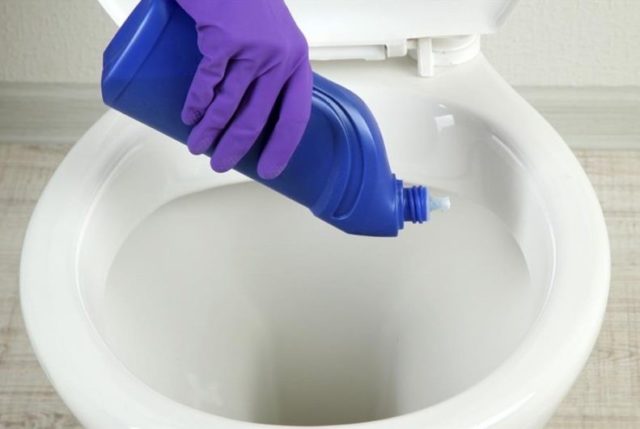
How to remove rusty deposits in the toilet with specialized products
It is possible to clean rust on the surface of plumbing not only with household alkalis and acids. In hardware stores, there are many specialized substances for toilet care. They can be divided into several categories, each of which has its own characteristics.
Alkaline specialized products
Alkaline cleaning gels have a high pH level and are useful in removing light to medium rust deposits on plumbing fixtures. Among the most famous names are Domestos, Bios and De Laval, Sif and Baxix.
All specialized alkalis are used according to the same algorithm. The gels are spread over the inner walls of the plumbing fixtures and left for half an hour, and then they are carefully treated with a sponge or toilet brush and the water is drained.
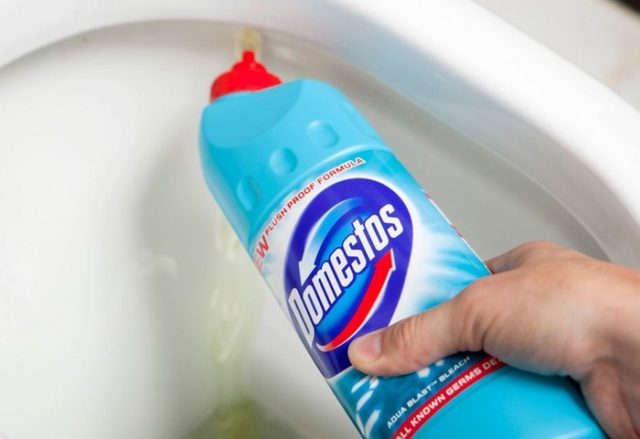
Acidic products
Specialized chemistry, which contains strong acids, is in great demand. Acidic gels are more effective in fighting rust, they allow you to clean tough dirt quickly and without much effort.
Among the most popular gels are Sanfor, Silit Bang, Sanox.
The advantage of acidic substances is that they are more corrosive than alkaline ones and are better at helping to clean the toilet of rust, urinary stones and limescale. Such gels are applied in a standard way, evenly spreading over the surface of the plumbing, but they need to be kept less, usually no longer than 10 minutes. This time is enough for the acids to dissolve the rust, and then it turns out to be cleaned almost effortlessly.
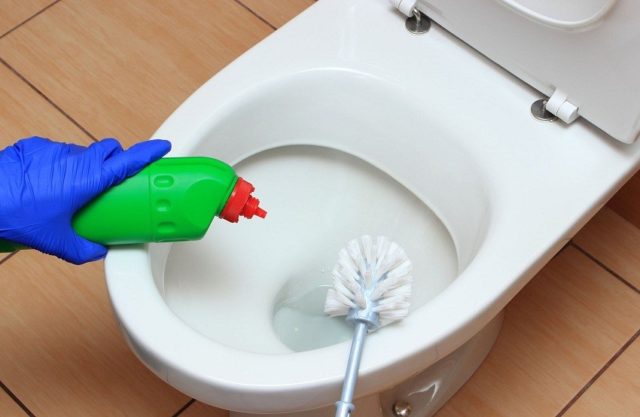
When using acidic products, you need to remember to be extra careful. Work with aggressive gels with gloves and a respirator. It is not recommended to keep the gel in the toilet for longer than the time specified in the instructions, this will help clean the toilet, but the acid can damage the surface of the faience and disrupt its smooth structure. If the walls of the toilet become rough and porous, rust will appear faster.
Abrasive cleaning powders
Powder chemistry is also popular, but it is used less often than alkaline and acid gels. Known abrasive powders include Komet, Pemolux, Sanita, Anti-Rust.
Abrasives are good for getting rid of rust in the toilet, they can be used to clean even a very dirty toilet. But powders have a significant drawback - the essence of their action lies in the fact that hard abrasive particles simply "tear off" rusty deposits from the walls of the plumbing. At the same time, the powders scratch the very smooth surface of the toilet bowl, leaving microscopic damage on it.
In the future, rust in the toilet will appear faster, since solid deposits will accumulate in indentations that are invisible to the eye. Therefore, it is recommended to use powders in exceptional cases, it is better to give preference to cleaning gels.
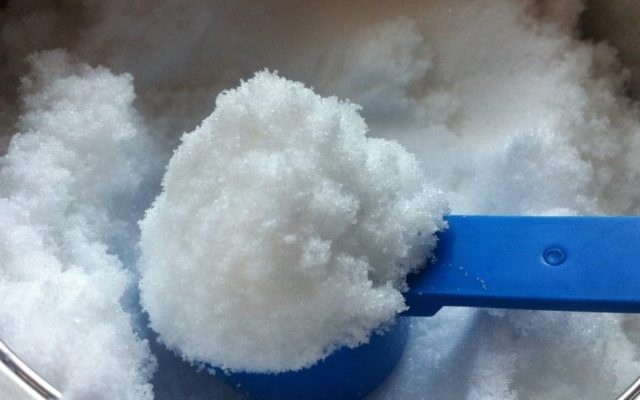
Preventing rust in the toilet
With good care of the plumbing, the appearance of rust can, in principle, be prevented, and then you do not have to spend energy to clean the toilet of yellow plaque:
- It is necessary to take the time to clean the plumbing regularly, at least once a week, using alkaline or chlorine-containing products.
- It is necessary to monitor the health of the toilet and carry out minor repairs on time. If water leaks even a little from the tank, yellow stripes on the walls of the plumbing will appear much faster, and it will not be possible to completely remove rust from the toilet, even with the help of strong means.
- The condition of the toilet is influenced by the quality of the tap water. If the water is too hard and with an admixture of rust from the pipes, then a yellow coating on the walls of the plumbing will appear faster. In addition, poor-quality water often leads to breakdowns in the drain system. You can solve the problem by putting special tablets in the toilet bowl, which help to clean and soften the water.
- Rust forms more quickly in the toilet if the water pipes have not been changed for too long and are rusted. It is recommended to change old pipes, this will not only facilitate the care of the plumbing and help to clean it faster, but will also avoid accidents.
When using the toilet on a daily basis, it is necessary to keep it clean with a brush. Food leftovers and fatty broths should not be poured into the sewer, all this leads to the formation of a thin fatty film on the walls of the plumbing. In this case, rust occurs faster. If the toilet bowl is still used for food waste disposal, then immediately after draining the food residues, it must be cleaned with a brush.
Conclusion
It is quite possible to clean the toilet bowl from rust at home. Even if the plaque is very old, it is not necessary to buy new plumbing - acidic and alkaline agents dissolve dirt well. Keep in mind, however, that regular maintenance helps keep your plumbing clean with minimal effort.
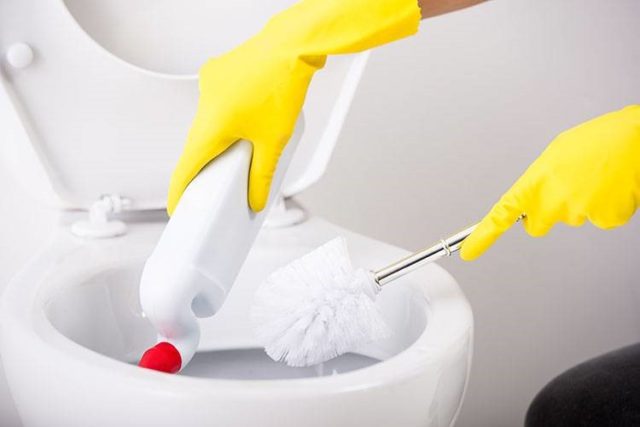
Reviews on how to remove rust on the toilet

